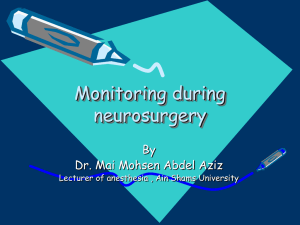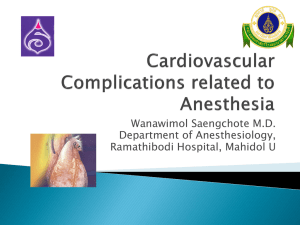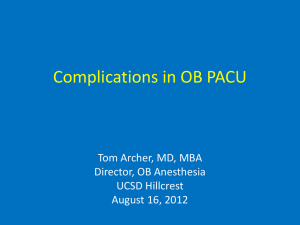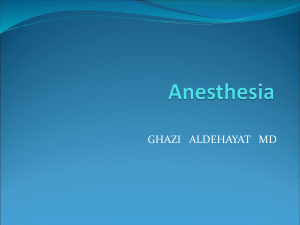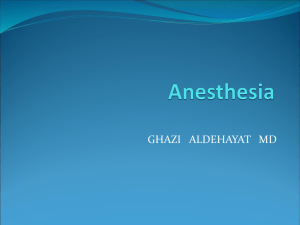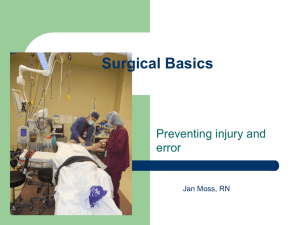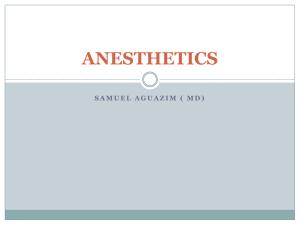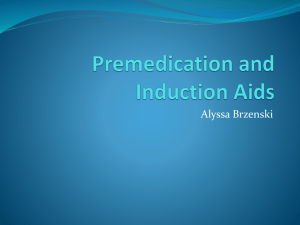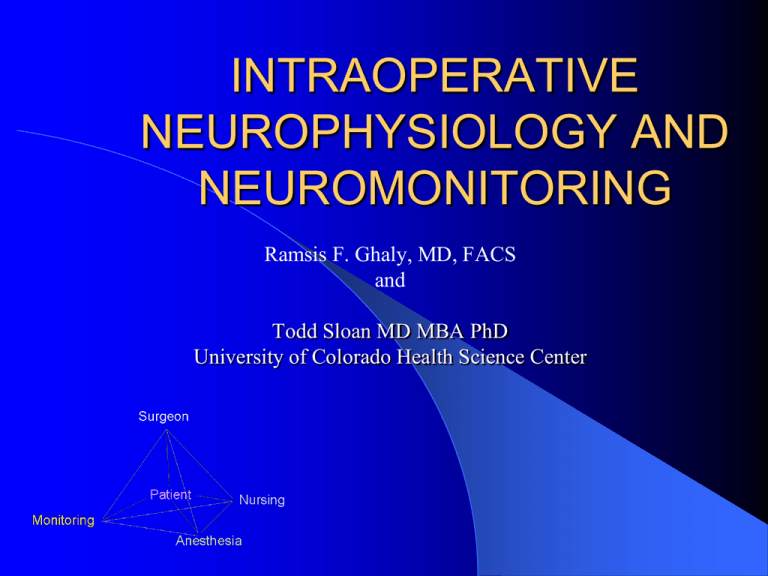
INTRAOPERATIVE
NEUROPHYSIOLOGY AND
NEUROMONITORING
Ramsis F. Ghaly, MD, FACS
and
Todd Sloan MD MBA PhD
University of Colorado Health Science Center
EEG MONITORING UNDER
ANESTHESIA
VISUAL DIAGRAM (COMPRESSED SPECTRAL
ARRAY)
ANALYSE (SPECTRA)
COMPRESS AND SPPRESS
SMOOTH
(Delta Theta Alpha Beta in a diagram Time against Hz)
NUMERICAL VALUES
BIS
Bispectral Index
Set of features on EEG(bispectrum, etal)
combined and correlated with regression to
clinical exam.
Bispectrum: A measure of the level of phase
coupling in a signal, as well as the power in
the signal
BISPECTRAL INDEX (BIS)
DIGITALIZE RAW SURFACE EEG (15-30SEC) AND PROCESS FREQUENCY
AND AMPLITUDE AND CORRELATE TO DEPTH OF ANESTHESIA
70-75% RECALL OF WORDS OR PICTURES DEPRESSED
<70% EXPLICIT RECALL SIGNIFICANTLY DEPRESSED
60-40% GENERAL ANESTHESIA
40-60% TARGET IF OPIODS USED AND 35% IF NO OPIODS
TIVA, HEMODYNAMIC INSTABILITY TO REDUSE ANESTHETIC DOSAGES,
SPEED RECOVERY, CLOSED-LOOP ANESTHESIA
INTERFERENCE FROM EXTERNAL, MECHANICAL AND MUSCLE ACTIVITY
SEIZURE SPIKE ERRONEOUS VALUES
HYPNOTIC AGENTS MAY NOT HAVE LINEAR RELATIONSHIP e.g. N20,
KETAMINE, OPIODS, ETOMIDATE
ANESTHETIC EFFECTS ON
EEG
DRUG TYPE- DOSE-RELATED (DEPTH OF ANESTHESIA)
AMPILTUDE-FREQUENCY-PATTERN- HEMISPHERIC SYMMETRY
INTRAVENOUS AGENTS
FAST ACTIVITY- SLOW & HIGH VOLTAGE
EPILEPTIFORM ACTIVITY (KETAMINE-METHOHEXITAL)
INHALATIONAL AGENT (FAST-LOW)
SUB-MAC: FAST ACTIVITY (15-30Hz)
1 MAC 4-8 Hz - 1.5 MAC 1-4 Hz - 2-2.5MAC BURST SUPPRESSION
SPIKE WAVE EEG (ENFLURANE)
ISOLECTRIC EEG
ANESTHETICS PRODUCING
BURST SUPPRESSION
BARBITURATE
ETOMIDATE
ISOFLURANE (2-2.5MAC)
SEVOFLURANE
DESFLURANE
INTRAOPERATIVE EEG
MONITORING
BISPECTRAL ANALYSIS (BIS) BIS guided
anesthesia demonstrated superiority in monitoring
depth of anesthesia, minimize awareness under
anesthesia, reduction in anesthetic utilization,
guide delivery, fast awakening. Spectral Entropy,
a measure of disorder in EEG activity, is being
evaluated.
FACTORS AFFECTING EEG
HYPOXIA
HYPOTENSION, ISCHEMIA (e.g.CEA)
HYPOTHERMIA
HYPO-AND HYPER-CARBIA
BRAIN DEATH
SURGERY:UNTOWARD EVENTS
CEA- CARDIOPULMONARY BYPASSCEREBRAL ANEURYSM CLIPPING
EVOKED POTENTIALS
SSEP/SEP
ABR/BAEP
VEP
MEP
EVOKED POTENTIAL
EVOKED STIMULUS (AUDITORY ABR/BAER-VISUAL VEP-SOMATOSENSORY
MN/ULNAR/PTN/CUTANEOUS SSEP) EEG IS SPONTANEOUS
TRAVELLING PATHWAY
RESPONSE (CORTICAL- SUBCORTICAL-SPINAL) (NEAR FIELD LATE
LATENCY ABR/SEP- FAR-FIELD BAER/SSEP SHORT LATENCY)
EP CHALLANGES
MINUTE POTENTIALS IN MICROVOLTS COMPARED TO EEG IN MV
ELECTRICAL ARTIFACTS
LENGTHY AND MULTIPLE SYNAPTIC TRACTS AND VULNERABILITY TO
ANESTHETICS AND EXTERNAL FACTORS
TECHNIQUE FOR REPRODUCIBILITY
AVERAGING
AMPLIFIER
Posterior Tibial N. SSEP
Primary
Sensory
Cortex
Med.
Lemniscus
CervicoMedullary
Junction
stimulus
Spinal
Cord
Auditory Brainstem
Response
VISUAL EVOKED
POTENTIALS (VEPS)
EYE GOGGLES AND OCCIPITAL
ELECTRODES
RETINA-OPTIC NERVE-OPTIC- MED.
GENICULATE-OCCIPITAL CORTEX (VP 100)
PITUITARY, SELLAR AND SUPRASELLAR
SURGERIES
VARIABLE AND VULNERABLE UNDER
ANESTHESIA
ANESTHETIC EFFECTS ON
EPS
LATENCY DELAY
AMPLITUDE REDUCTION (EXCEPT
ETOMIDATE AND KETAMINE)
VARIABLE AMONG AGENTS
WORSE IN INHALATIONAL AGENTS AND
DOSE DEPENDANT
ADDITIVE EFFECTS OF AGENTS
VEP>SEP>BAER
FACTORS AFFECTING EPS
RECORDING UNDER ANESTHESIA
HYPOTHERMIA
HYPOXIA
HYPOTENSION/ISCHEMIA
ANESTHETIC AGENTS
SURGICAL FACTORS: INJURYCOMPRESSION- RETRACTION
INTRAOPERATIVE MEP &
EMG INCLUDING CRANIAL
NERVE MONITORING
ElectroMyoGraphy
SSEP cannot
evaluate individual
nerve roots
•Operative Monitoring
–Nerve irritation
–Nerve identification (stimulation)
–Pedicle screw testing
–Reflex testing
–(Motor evoked potentials)
Methods for Cranial Nerve Monitoring
II
III
IV
V
Optic
Oculomotor
Trochlear
Trigeminal
VI Abducens
VII Facial
VIII Auditory
IX Glossopharyngeal
X Vagus
XI Spinal Accessory
XII Hypoglossal
sensory: VEP
motor:inferior rectus m
motor: superior oblique m
motor: masseter and/or
temporalis m
motor: lateral rectus m
motor: obicularis oculi and/or
obicularis oris m
sensory: ABR
motor: posterior soft palate
(stylopharygeus m)
motor: vocal folds, cricothyroid m
motor: sternocleidomastoid m
and/or trapezious m
motor: tongue, genioglossus m
Facial Nerve
Monitoring
Bursts
Neurotonic
100 msec
30 sec
Muscle relaxation is
usually avoided in
monitoring
spontaneous EMG
(amplitude dec.) cn 9,10,11,12
cn 10
cn 3,4,6
cn 9,12
Which Nerves?
Cervical
C2, C3, C4Trapezius, Sternocleidomastoid
Spinal portion of the spinal accessory n.
C5, C6
Biceps, Deltoid
C6, C7
Flexor Carpi Radialis
C8, T1
Abductor Pollicis Brevis, Abductor
Digiti Minimi
Thoracic
T5, T6
T7, T8
T9, T10, T11
T12
Upper Rectus Abdominis
Middle Rectus Abdominis
Lower Rectus Abdominis
Inferior Rectus Abdominis
Lumbosacral
L2, L3, L4 Vastus Medialis
L4, L5, S1 Tibialis Anterior
L5, S1
Peroneus longus
Sacral
S1, S2
Gastrocnemius
S2, S3, S4 External anal sphincter
Stimulator
ANESTHETIC REGIMEN
FOR INTRAOPERATIVE
NEUROPHYSIOLOGICAL
MONITORING
Anesthesia Components: Analgesia
and Sedation/Amnesia
Opioids
Ketamine
•Morphine
Dexmeditomidine
•Demerol
•Fentanyl
•Alfentanil
•Sufentanil
•Remifentanil
Fentanyl
Excellent drug, blocks pain
in pathways not used by
IONM such that sedative
drugs that do hamper IOM
can be kept at lower level
Sufentanil
Fentanyl
MEP
SSEP
Ketamine
Perspective:
Provides amnesia and analgesia
Inexpensive as infusion in TIVA
Problem of hallucinations
Increases ICP with
intracranial pathology
May inc seizures
Anesthesia Components:
Analgesia and
Sedation/Amnesia
Barbiturates (thiopental, methohexitol)
Benzodiazepines (midazolam)
Propofol
Etomidate
• Droperidol
• [Ketamine]
• [Dexmeditomidine
Propofol is the most common
TIVA sedative
Muscle Relaxation
Paralysis ok during intubation and some other
times (e.g. back incision)
Full paralysis may be necessary to reduce EMG
interference near recording electrodes
( e.g. SSEP cervical response, epidural or neural
response)
Full or partial paralysis may reduce patient
movement with stimulation
Partial paralysis may be acceptable for
electrically stimulated pathways
Absence of paralysis may be necessary with
mechanical stimulation or with pathology
Motor Evoked Responses: Start
with TIVA
- Induction with appropriate medications
(limit barbiturates and benzodiazepines)
Using short to intermediate acting relaxants
Propofol 1-2 mg/kg
Succinylcholine, vecuronium, rocuronium, etc.
-
Basic maintenance with TIVA
Propofol 120-140 mg/kg/min
Sufentanil 0.3-0.5 ug/kg/hr
-
Use EEG to guide propofol
No nitrous oxide, No potent inhalational
No muscle relaxation
Desflurane 3%
inhaled (1/2
MAC) may be
tolerated in
healthy
patients
Summary: Effective Anesthesia
Work with monitoring to develop an anesthetic
plan based on monitor techniques used
Start the case with the best anesthesia possible
and begin monitoring (use a bite block!)
Review the responses
Liberalize or improve anesthesia
Hold the physiology and anesthesia steady
Develop an anesthesia
“protocol”
THANK YOU FOR
LISTENING
QUESTIONS?

